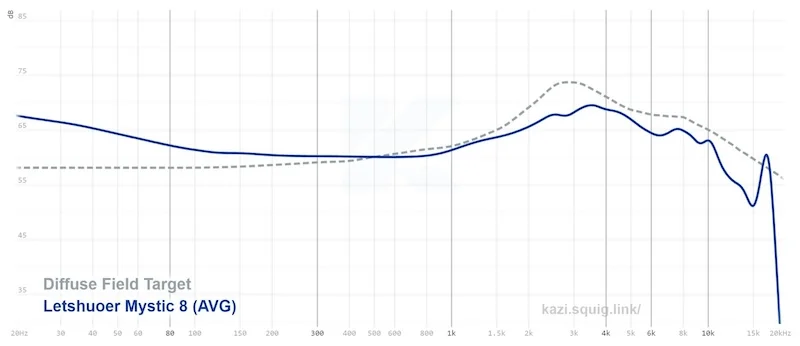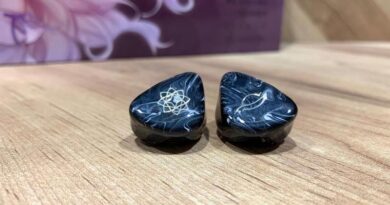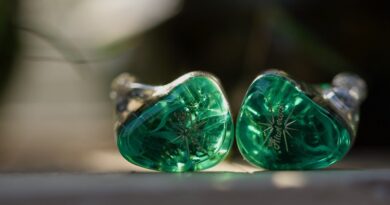Letshouer Mystic 8 Review – Effortless Clarity
Pros — Exceptional craftsmanship
– Titanium shells provide superior comfort
– Rich midrange with excellent timbre
– Airy, sparkly treble
– Natural rendition of instrument layering
Cons — Sub-bass on the Mystic 8 lacks rumble and body
– Unsatisfactory macrodynamic punch
– Faceplate design might be divisive
In this Article
INTRODUCTION
My first encounter with Letshuoer was almost five years back, as I tried one of their earliest releases: the Tape. It had a unique magnetostatic driver which was rare in the market and offered a somewhat unique timbre. Later, I reviewed both the S12 and Z12 planar IEMs, but did not have a chance to try one of their upper-tier models.
Fast forward to High End Munich 2023, and I got a first glimpse at what a flagship Letshouer IEM can sound like with the Cadenza 12. My interest in the brand got rekindled, and two years later, the Mystic 8 is here to fill the gap between the flagship and lower-tier Letshouer offerings.
Letshuoer Mystic 8 has an all-BA driver setup, a unique faceplate design, alongside an intricately crafted Titanium alloy shell to stand out amidst a sea of similar offerings. Ironically, what sets these IEMs the most is not the feline-inspired decor, rather how they actually sound. Read on.
Note: the ratings given will be subjective to the price tier. Letshuoer was kind enough to send me the Mystic 8 for evaluation.
Sources used: Questyle CMA Eighteen Master, Lotoo PAW Gold Touch
Price, while reviewed: USD$989. Can be bought from Letshuoer official website.
PHYSICAL THINGS AND USABILITY
The packaging is elaborate and full of some “unexpected” accessories. While the usual affairs are there, i.e. a 4.4mm cable, 9 pairs of eartips, and a carrying case; you also get a pendant and a necklace. I’d never wear those but some might so I ain’t judging.
The stock cable seems to have been a common source of dismay among many owners, but I do not find it to be unusable or such. It has a grippy texture on the sheathing that tends to get tangled easily, but I found it to be more manageable if I kept the chin slider up until the middle of the length. From a cable material perspective, the wire is absolutely fine and should not need replacing for a “sonic upgrade”.
The stock tips offer different sound tuning options but I ended up with Final E-type Clear tips which offered the best balance between the lows and ultra-highs for me.
As for the design, the Mystic 8 faceplate will likely divide opinions and might even be a deal-breaker for some. While I am fine with the cat silhouette, the faux-diamond inlay takes it a bit overboard. Nonetheless, the overall aesthetics is far from gaudy and a stark departure from the waifu-themed IEMs that are in vogue nowadays. The titanium-alloy shell has a black PVD finish and has a unique feel in hand. It’s lightweight yet sturdy.
As an aside, I am quite impressed by the CNC machining, especially the molding of the inner-side that used to be a challenge with Titanium not too long ago. It seems the production methods have improved dramatically to offer such intricate shaping of Titanium alloy at a more accessible price point.
In terms of comfort, despite the singular vent located near the nozzle, there is some pressure buildup if you listen to these IEMs for hours. I think a back-vent would alleviate this issue.
At 107 dB/mW sensitivity and 18 ohm impedance, the Mystic 8 are easy to drive. Most modern dongles should power them from the 3.5mm jack alone, but to get more headroom in terms of distortion and dynamics, going balanced might be the better option. However, I would not pair these IEMs with a very sterile or “clinical” source as the pairing might veer too much into “analytical” territory. For the majority of the review, I used the desktop Questyle CMA Eighteen Master as the source while using the Final E-type tips and the stock cable. I also used the Lotoo PAW Gold Touch for portable listening and found the overall presentation to be similar between the sources.
DRIVER SETUP AND SPECS
Letshuoer Mystic 8 utilize an 8 BA driver setup, with the four midrange and bass drivers being Sonion, while the treble and ultra-high frequencies being handled by Knowles tweeters.
On paper, this would be a four-way crossover, but Letshuoer did something interesting. The crossover is a three-way setup (lows, mids, and highs) while the drivers have a four-way physical tube structure. This means that two of the tubes share the same crossover frequency (likely the treble frequencies). While this increases the nozzle diameter (as opposed to unifying the tubes within the shell and then passing a single tube to the nozzle), this can also increase the effective SPL of the treble frequencies.
The bass drivers also include some low-pass filters inside the acoustic pathway, which ensures the passage of only low frequency signals. I think Letshuoer could have opted for a more sophisticated method here, since physical low-pass filters tend to dampen the leading edge of notes and reduce the impact and dynamism of the sound. Nonetheless, the overall acoustic structure along with the BA-only design ensure a very coherent, timbrally correct response and that’s pretty rare in the market due to the abundance of tri-brid or even quad-brid setups.
HOW DO THE LETSHOUER MYSTIC 8 SOUND?
The Mystic 8 has a mostly neutral response with a somewhat elevated upper-treble. However, that description sells the midrange tuning short.

It is the midrange that sets the Mystic 8 apart from its apparent competition. While majority of the IEMs nowadays focus on a more “in-your-face” sub-bass rumble and overdone airiness, the Mystic 8 takes an appreciably reserved stance. A bit too reserved, perhaps, as the mid-bass is not as “meaty” or “weighty” as I would prefer, while the sub-bass rumble is not satisfactory for many of the bass-heavy genres. You won’t miss any of the bass notes, they just won’t have the expected depth behind them.
The lower midrange is ruler-flat and the sub-bass shelf starts from 150Hz downward. This can make the baritone vocals sound a bit under-nourished, but due to the less overzealous sub-bass shelf it’s actually fine and has a monitor-like tone to the male voices. The upper-mid tuning is rather interesting with two distinct peaks near 2.5kHz and 3.5kHz, while there is a dip before and after these peaks. What this does is essentially provide the appropriate pinna gain for most canal shapes out there.
I do think the latter 3.5kHz peak is a bit too elevated for certain songs (e.g. Avril Lavigne’s Nobody’s Fool) and can introduce some shout for very sensitive listeners. The lack of mid-bass body can make this more evident, so I’d recommend a deeper fit to somewhat dampen the response in this are.
Nonetheless, despite the slight coloration, the mids sound exceedingly natural in terms of female vocals and strings. In fact, I found the Mystic 8 especially suitable for acoustic and singer/songwriter tracks. One of those rare specialist IEMs that will reward you with the right tracks and/or albums.
As for the highs, this is one of the best BA trebles I’ve heard in ages. The usual metallic sheen of BA drivers is entirely absent here and the cleanliness of the treble is comparable to well-implemented EST driver hybrids. It still lacks the note weight and “snap” of some dynamic driver IEMs (e.g. Sony IER-Z1R or the Sennheiser IE 900) but that’s more of a difference in presentation than an outright con. Cymbals and hi-hats decay with the leading and trailing edges of notes being perceptible the entire time. You can easily make out when the drummer hits the rim of ride cymbals vs the bow – a hallmark of well-tuned highs.
In terms of staging, the Mystic 8 projects a somewhat oval stage rather than an elongated one. As such, stage width is not as pronounced while stage depth and height are well done. I won’t call this a “holographic” stage per se, but it gets close to that descriptor. Imaging is accurate with the distance between instruments being apparent, as can be heard on Damien Rice’s Cheers Darlin.
Due to the somewhat limp bass response, macrodynamic punch is not as satisfying or pronounced during electronic tracks or sudden bass drops. Mircodynamics are surprisingly good however, with slight changes of volume being vividly portrayed. Instrument layering is another strong aspect with multiple instruments playing at the same time have distinct delineation between them.
LETSHUOER MYSTIC 8 VS. LETSHUOER CADENZA 12 (2024)
Despite the massive price gap between Letshouer’s flagship Cadenza 12 and the half as expensive Mystic 8, I found these IEMs to have a contrasting presentation and each had its own strength.
The bass response on the Cadenza 12 is far more voluminous and can even get too much at times, with the sub-bass being ever-present in most tracks and offering a depth that’s imperceptible on the Mystic 8. However, the mids on the Mystic 8 sound more open and even in bassy mixes you never miss any subtleties of the vocals. The treble is more pronounced in the mid-treble on the Cadenza 12, while the lack of bass emphasis makes the upper-treble stand out a bit more on the Mystic 8.
Overall dynamics are superior on the flagship, and the same applies to imaging and staging which are more holographic on the Cadenza 12. I guess this is where you start getting your extra money’s worth. In the end, I found the Mystic 8 to be more enjoyable in “sparser” tracks where the vocals or the strings were the centerpiece. The Cadenza 12 does far better with modern genres or tracks that have large dynamic swings.
CONCLUDING REMARKS
I am truly impressed at the evolution of Letshuoer as a brand and the maturity that they’ve shown with the recent releases. Every release has a specific target audience in mind with a well-executed tuning that reflects that idea.
The Mystic 8 is not without its drawbacks. Most notably, the bass might just be too little and too feeble for certain genres and tastes. As such, these would not be my pick as an “all-rounder” pair of IEMs for those willing to spend on only one high-end pair.
However, if you are building a collection and appreciate a naturally voiced midrange and treble, the Mystic 8 is a must listen. It highlights the subtleties so well that I find myself enamored during the listening sessions, and that’s a statement I have reserved for only a select few IEMs in the market.
MY VERDICT
4.25/5
DISCLAIMER
Our generic standard disclaimer.







